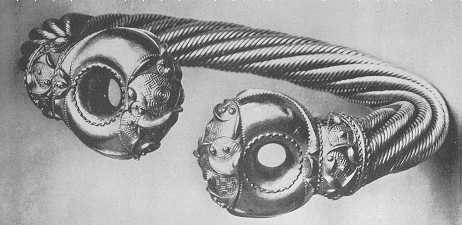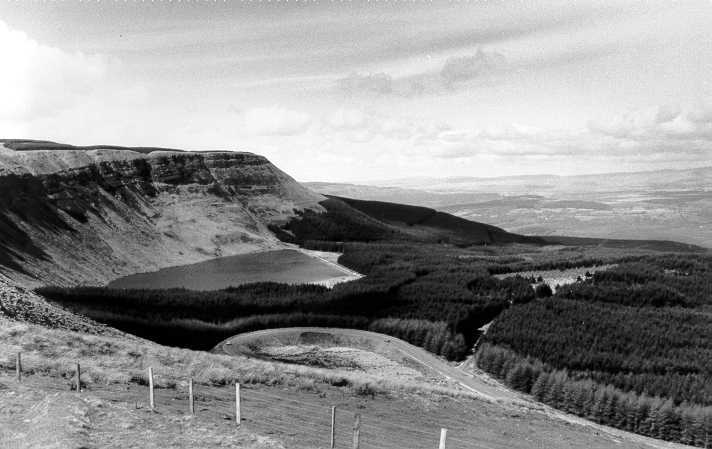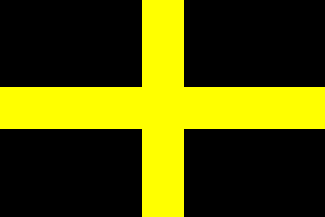
A gold torc, or torque, an open necklace, that might well have still been worn in the dark ages (coin in terminal dated to c.50 BC, Snettisham treasure).
"Arthur was not king of Britain, or even a local king, except in the petty Irish sense. We may picture him as a rustic noble, born in the 470s or thereabouts, of still dimly-Romanised stock. Hence his name, Artorius. His youth was spent in raiding and feuding. By an unusual flair for leadership he attracted a following. His personal corps - the 'knights', if we care to use the word - aided British kings against Anglo-Saxon encroachments. He made himself indispensable over the whole zone of his operations, becoming Ambrosius' successor and, in a crude way, a statesman. But, despite victory, his standing was never quite secure. Quarrels with the monks, probably over levies in kind, deprived him of proper recognition in the writings of the only people who wrote. He met his end fighting an enemy to whom there is no reason not to give the name Modred."
(Geoffrey Ashe: 'The Quest for Arthur's Britain', 1968, p50, highly recommended)

Llyn Fawr - now enlarged as a reservoir, site of numerous sword deposits.
Chronology Tintagel, Castle Dore, Dinas Powys, Degannwy, Glastonbury Abbey, Glastonbury Tor and South Cadbury were all inhabited during the years which range from 80 years before the conjectural date of Arthur's birth (c.480) to one hundred years after the date at which he is believed to have died (c.540).
358 - 477 AD
480-490 Probable lull; St Germanus' biographer speaks of Britain as prosperous.
495? Cerdic, the West Saxon leader, lands from Southampton Water.
500 Angles and Saxons on Humber, in north Lincolnshire, in East Anglia, Essex, Middlesex, Sussex, Hampshire and advancing from the Wash toward the Upper Thames; Jutes in Kent and the New Forest. British migration to Armorica continuing (and throughout this century), but some success at home in containing the invasion. Arthur among the British leaders. St Illtyd at Llanilltyd Fawr (Llantwit Major) during first quarter of 6th century. Many disciples and strong forward movement of Church in west.
508? Cerdic defeats Britons in Netley Marsh.
516 or 518 Britons under Arthur win great victory at 'Mount Badon', probably regaining lost ground in Thames valley and north-west of London. After this, a phase of British ascendancy and comparative peace, with some Saxons returning to the continent. Gildas, Cadoc, David and other important ecclesiastical figures active during the next half-century. Britons assisting Irish Christianity. Monastery at Glastonbury on present site.
========= 531 In September a comet is seen for 20 days in the western quarter of the skies, which shot its rays into the north. This is now known to have a period of 575 years.
535 In February a loud bang is heard to the south west of China.
536-537 Development of lake forts in Ireland, tree rings indicating frosts in summer. Sun dark for 18 months in Rome, shining 4 hours a day, crop loss through cooling. Sulphuric acid peaks in ice cores from both poles. Overall cooling, less rainfall, famine followed by floods. 537 given as one date for battle of Camlann (539 being another) and death of Arthur.
539 Comet seen whilst Sun in Capricorn, which appeared to follow in the Sagittary; size gradually increasing; head in the east, tail in the west, visible for more than 40 days. If sword-like in appearance would attribution to Lug have been made?
540 'Battles in the air', famine in Japan, yellow dust falling like snow in China (Krakatoa again, or fallout from the comet?)
541 Where 'sky rained blood' people died in large numbers. Could this have been particulate iron?
542 Tree rings again affected. Another date for Arthur's death. First records of bubonic plague reaching Constantinople from Ethiopia, fed by ivory trade, up to 10,000 people dying a day, the counting being abandoned when it exceeded ¼ million. Last repair of Marib Dam (Yemen), abandoned after damage from flash floods, many people moving to Mecca and Medina. It is possible that one group of Jews made it as far south as Southern Africa.
545 The five kings denounced by Gildas ruling over western Britain about this time, Maelgwyn of Gwynedd being the most important.
546 Goths took Rome.
547 Yellow Plague arrives in Britain through Cornish ports, Celts being exposed because of trade with Rome. Death of Maelgwyn.
========= 552? West Saxons resume advance. British defeat at Salisbury.
563 St Columba founds Iona.
570 Oldest surviving Welsh poetry: Taliesin, Aneirin, Llywarch Hen, Myrddin ('Merlin'). Urbgen of Rheged drives back the northern Angles. Mohammed born in Medina.
571? Saxons overrun British enclave in Buckinghamshire.
577? British defeat at Dyrham. Loss of Bath, Cirencester and Gloucester. 'West Welsh' isolated.
593-603 Aethelfrith of Northumbria gaining ground in the north. British defeat at Catterick (Gododdin).
597 St Augustine in Kent.
597-603 Aethelfrith routs Aedan, King of Scots.
603 Welsh bishops refuse to co-operate with Augustine.
616 Aethelfrith defeats Welsh at Chester, cutting off Wales from the north.
632-633 Welsh invasion of Northumbria defeated. End of effective British challenge to Anglo-Saxons. After this date, Celtic missionaries are active in most of the Anglo-Saxon territory.
The period around Arthur's death was a pretty dire time to live for a large number of people across the world. Byzantium, at it's height, diminished hereon. Islam grew in influence. Evidence at Teotihuacan (est pop: 125,000) shows that babies were affected by their mothers ill-health, 70% of burials consisting of those under 25. Revolution was followed by the destruction of the city. In Yucatan, lake deposits indicate a 30 year drought, whilst Columbia was at its driest for 3,000 years. 540-600 is considered, by some sources, to include a 40 year drought brought about by a change in the Humboldt current, a period when temple mounds were abandoned on the pampa and the creation of the Nazca figures and lines began. An adjacent area, around 600-650, suffered 30 years of drought, then 30 years of flood. Violent rituals depicted on pottery were shown archaeologically to have a basis in reality.
Around the same period cooling and driness contributed to the Avars (a predominantly horse-based Mongolian culture) being overcome by those cultures based on cattle (the cow has a more efficient digestion than a horse), these people then moving on as far as Hungary (about 550s).
The chronology above is based on notes derived from Edward Gibbon, Geoffrey Ashe and two documentaries based around 'Catastrophe: A Quest for the Origins of the Modern World' by David Keys (not read by myself, but dealing with the consequences of an eruption of Krakatoa that threw magma some 30 miles high (40 teraton yield) and criticised by others. There are, however, arguments for comet or meteorite strikes, in addition to volcanic fallout), et al. See also details of eruption of Toba and the resultant consequences for human mitochondrial DNA (also Yellowstone). Any inaccuracies are entirely mine, and additions or corrections are welcomed.
Dendro dates show an event centred on 1159 BC conjectured to have been caused by a comet 'grazing' the atmosphere (same as 542 AD above?). There was no summer in Britain for 18 years and torrential rain caused flooding that rendered Dartmoor uninhabitable. A causeway at Flag Fenn, dated to this time, and its attendant wealth of rich ritual deposits indicate a statement against this flooding, although Sun worship would persist until its revival nearer Roman times. Quite a number of “narrow tree-ring events” have been detected that are dated to 4370, 3195, 2350, 1628, 207 and 44 BC. The sheer number of such narrow tree-ring events suggests that we may be dealing with recurrent abrupt cooling events. Essentially all of these 'events' have also been evidenced in form of major acidity peaks in Greenland and Antarctic ice cores that appear to match the dendrochronological records. As a result, all of the narrow tree-ring events are strongly correlated with volcanic eruptions that are thought to have generated climatic downturns.
The eruption of Thera (1628 BC) seems to have resulted in Minoan society appearing to fragment, with the arrival of tsunamis, 'marine-style' vases, idols and ritual cannabalism. It has even been suggested that a vital trading port was built on an island in the middle of Thera's caldera. There was no summer in Ireland for 10 years after this event.
Mammoth are often found in a line, indicating that they were moving at the time that the inundation of snow overwhelmed them, some indicating death by suffocation rather than by hypothermia. The severity of the event is exemplified by animals' natural tendency to avoid dangerous situations, including tsunamis, which failed completely in this case.
With a population density some two hundred times higher, one ponders how our society would cope.
An interesting suggestion has been put forward by an individual whose study of medieval and 16th century texts has indicated that differences between Roman cursive texts and those of the Roman church, when translated across languages, appear to hint at a much older source to the legend. It is suggested that, like Pendragon, Arthur is not a name but a title, and that Camelot did indeed exist and still does, under the Severn estuary. It has been recognised since the early 20th century that archaeological remains of prehistoric human habitation are also present on the sea-bed, which contains sediments dating from throughout the last 500,000 years and much of which has only been submerged for the last 5,000 when sea-level climbed to within 10–12m of its current height.

An excellent analysis of this period can be found in Dr Francis Pryor's 'Britain AD: King Arthur's Britain' (a Diverse production for Channel 4).
Samain, 1st November, notably remembered as a time when people from the síde (afterlife, otherworld) walked amongst the living, thus Halloween.
Imbolc, 1st February.
Beltine/Cétshamain, 1st May, generally associated with fertility rites. Walpurgisnacht, the night before Beltine, was thought to be when witches met on the Brocken, or elsewhere, to hold revels with the Devil (Walpurga, 8th cent English woman saint).
Lugnasad, 1st August, although some tie in with Lug is obvious, fertility rites played a role here too.
For an interesting insight into earlier religions I would recommend to the reader the work of Robert Graves, especially 'The White Goddess', 'The Greek Myths' and the Larousse 'Encyclopedia of Mythology'.

Saints David and Illtyd might well have met Arthur face to face although they may very well have not seen eye to eye on many issues of the day (for an excellent introduction to the early British church, which differed markedly from the Roman church, see Geoffrey Ashe's 'King Arthur's Avalon' and William Dalrymple's 'From the Holy Mountain').
No one was more surprised than myself that a Norman reworking of a Celtic myth should weedle its way into my subconscious thus culminating in some prose. Such is the power of myth.
King Arthur's Labyrinth | The Legend of King Arthur | King Arthur Fact, Semi-legend or Myth? | Arturius - A Quest For Camelot | Where Didn't King Arthur Come From?